Capitol Record Club Issue
#03 Something New (ST-8-2108)
(Update: 13th. February 2025)


 Club Issue1st. Sleeve |
|
|
|
TITLE
|
SOMETHING NEW |
||||
| CATALOG
NUMBER |
ST-8-2108 |
||||
|
RELEASE DATE
|
early 1969 / First Press | ||||
| TITLE LISTING |
SIDE
1 |
SIDE
2 |
|||
| I'll Cry Instead
(BMI-2:04) |
Tell Me Why
(BMI-2:06) |
||||
| Things We Said
Today (BMI-2:35) |
And I Love Her
(BMI-2:28) |
||||
| Any Time At All
(BMI-2:10) |
I'm Happy Just To Dance With You (BMI-1:56) | ||||
| When I Get Home
(BMI-2:14) |
If I Fell (BMI-2:19) | ||||
| Slow Down
(BMI-2:54) |
Komm, Gib Mir
Deine Hand (BMI-2:24) (Lennon-McCartney-Nicolas-Hellmer) |
||||
| Matchbox (BMI-1:37) | |||||
| FRONT--> Click! | BACK --> Click! | SIDE 1 --> Click! | SIDE 2 --> Click! | DISK | |
 |
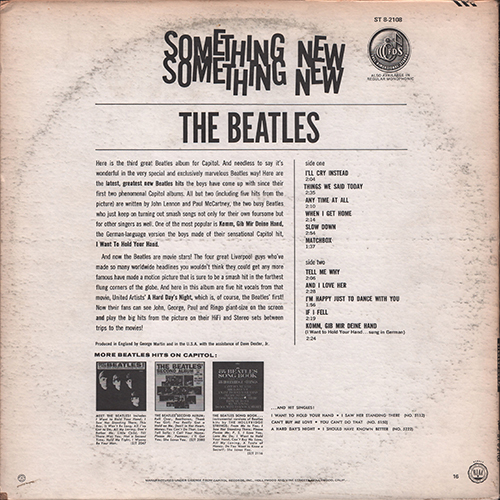 |
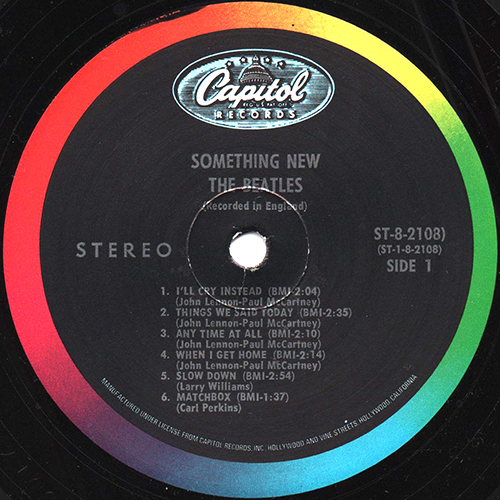 |
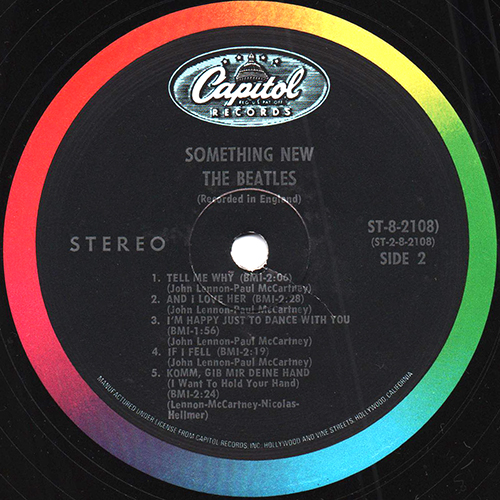 |
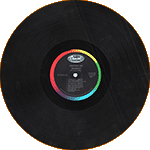 |
|
| INNER SLEEVE | FRONT COVER CLOSE UP | ||||
| FRONT--> Click! | BACK --> Click! | ||||
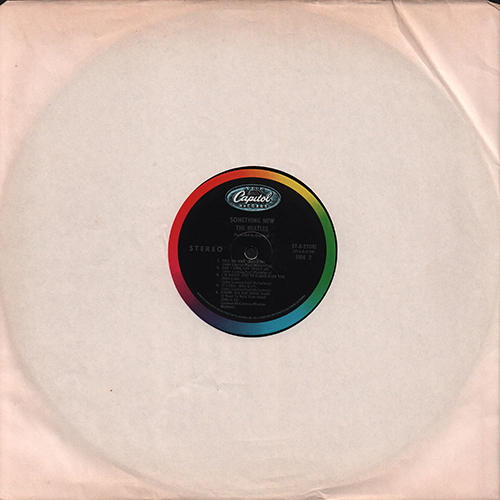 |
 |
 |
The Capitol logo and the
phrase "HIGH FIDELITY" appear in black at the right side of
the front cover. |
||
| FRONT COVER CLOSE UP | |||||
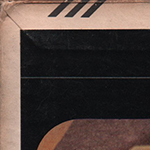 |
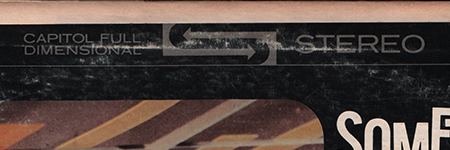 |
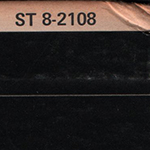 |
|||
| Copies of non gatefold Capitol
albums that were released through the record club from 1969
through 1972 have three "hash marks" at the upper
left hand corner of the cover. These are visible from the
front and distinguish the albums from Capitol's regularly
issued LP's. On stereo jackets, the front cover slicks is cut and positioned to reveal the Capitol Full Demensional Stereo arrow logo at the top. None of the original record-club covers have the gFile Underh dot. |
The first copy has the number
"ST 8-2108" in the upper right corner of the front
cover. |
||||
| BACK COVER CLOSE UP --> Click! | |||||
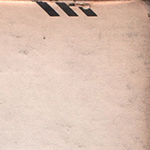 |
Have three "hash marks" at the upper right
hand corner of the front cover. |
 |
Back liner has the catalog number "ST 8- 2108". With "Full Dimentional Stereo" logo, WITH "Also Available In Regular Monophonic" letters under the FDS logo. | ||
 |
The back liners have a small
numeral located near the lower right or left corner. These
numbers were used by Capitol to identify where the album
cover was manufactured. (16 = Longines) |
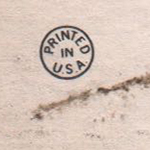 |
"Printed in U.S.A." in a circular pattern. | ||
| BACK COVER CLOSE UP | |||||
 |
|||||
| After Longines took over the
record club in 1969, Capitol quit supplying albums to the
club. Instead, Longines arranged for the manufacture of
Capitol albums using cover artwork and label backdrops
supplied by Capitol. Most of the back liners for the album
jackets prepared for Longines contain the legend
"Manufactured under license from Capitol Records, Inc.,
Hollywood and Vine Streets, Hollywood, Calif." in uppercase
letters. |
|||||
| LABEL CLOSE UP | |||||
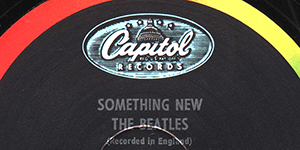 |
 |
The original issue was manufactured with black label backdrops with an outer rim colorband. "STEREO" indicator on the label has a chubby printing type. | |||
 |
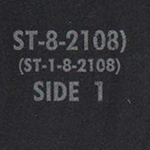 |
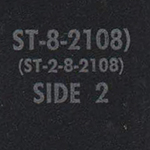 |
Longines altered the record
number of the LPs by adding the number "8" to the prefix.
The expanded record numbers appear on the record covers and
labels and in the trail off areas. Longines began pressing
Capitol Beatles albums in 1969, mono discs had been phased
out. Thus, there are no mono Longines pressings of Beatles
albums. |
||
| LABEL CLOSE UP | |||||
| SIDE 1 |
SIDE
2 |
The
club issue album labels have full "John Lennon-Paul
McCartney" credits. (excepted #5 on side-2) |
|||
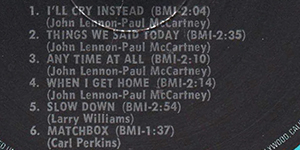 |
 |
||||
| LABEL CLOSE UP | |||||
 |
The text of the perimeter print in blue on
the club issue discs states "Manufactured under license from
Capitol Records, Inc., Hollywood and Vine Streets,
Hollywood, California" in uppercase. |
||||
|
OTHER ITEM
|
|||||
| - |
|||||
| LABEL | Capitol
Black
label with color band (Record Club Edition) |
||||
| MIX | STEREO |
||||
| VINYL COLOR | Black |
||||
| PRESS FACTORY | Longines |
||||
| FACTORY CODE | 16 |
||||
| MATRIX No. | SIDE 1 |
ST 1
82108 w1 21 (hand etched)
|
|||
| SIDE 2 |
ST 2 - 82108 w1 21 (hand etched) | ||||
| PUBLISHER'S NAME |
- |
||||
|
"SUBSIDIARY" PRINT
|
- |
||||
| COVER FORM |
Single type. Housed in a cardboard jacket. Front cover: with gloss varnish | ||||
| INNER SLEEVE | Plain
white inner sleeve |
||||
| COVER DESIGN/ PHOTO/ NOTES | photograph
taken by Ken Veeder of the group's 9th. February 1964, Ed
Sullivan Show debut |
||||
| PRODUCER | George
Martin |
||||
|
COMMENTS
|
When the Capitol Record Club began
operations in 1958, it entered a mail-order market dominated
by two clubs owned by other labels - Columbia and RCA. the
Capitol Records record club enticed people to join by
offering half-dozen or so "free" records in exchange for the
new member buying one record and agreeing to club membership
rules. Capitol's only hope of catching the competition was
to exploit the strength of its talent roster. Then in December 1968, Capitol had agreed to sell its direct marketing corporation, which included the Capitol record club to the Longines (Longines-Wittnauer) company. prior to Longines' purchase of the record club, The Beatles albums issued to club members were the same as the records shipped by Capitol to distributors and stores. After Longines took over the club in 1969, Capitol quit supplying albums to the club, instead Longines arranged for the manufacture of Capitol albums using cover artwork and label backdrops supplied by Capitol. The LP back covers have three angled black bars in the upper right hand corner which wrap around to the front cover in the upper left hand corner, and do not have the "File Under" information. Longines also altered the record number of the LPs by adding the number "8" to the prefix. By the time Longines began pressing Capitol Beatles albums in 1968, mono discs have been phased out. Thus, there are no mono Longines pressings of Beatles albums. These Longines Beatles albums are less common than the standard Capitol albums, which sold in the millions. The first records pressed for Longines have the Capitol rainbow label backdrops, while later issues have either green Capitol labels. "Something New (Capitol ST 2108)" is designated ST-8-2108. The expanded record numbers appear on the record covers and labels and in the trail off areas. None of the original record-club covers have the gFile Underh dot. The New Improved Full Dimensional Stereo logo was appeared at the top of the front cover slick. Back liner has the catalog number "ST 8- 2108". With "Full Dimentional Stereo" logo, WITH "Also Available In Regular Monophonic" letters under the FDS logo. The back liners have a small numeral located near the lower right or left corner. These numbers were used by Capitol to identify where the album cover was manufactured. (16 = Longines) On the label, The text of the perimeter print in blue on the club issue discs states "Manufactured under license from Capitol Records, Inc., Hollywood and Vine Streets, Hollywood, Calif." in uppercase. The club issue album labels have full "John Lennon-Paul McCartney" credits. (*) The Longines Symphonette Society: The Longines Symphonette Society was a direct marketing company working out of Larchmont and, later, New Rochelle, New York. These addresses were also printed on the labels of their releases. The company operated from the late-1960s until 1974, headed by Alan Cartoun, president, and son of Longines Watch Company Chairman, Fred Cartoun. The Longines Symphonette Society was a pioneer of using personalized computer-generated letters to promote LP records, 8-track tapes, electronics, books, and collectors' medallions. But their main business was mail-order LP box sets of classical and easy listening music, as well as releasing LPs of "old time radio" (OTR) programs. It purchased the record club edition rights to the catalog of Capitol Records from the label for its Capitol Record Club in 1968 and continued to press Capitol LPs for the club until 1975, when it was shut down. (from Discog) |
||||
|
TITLE
|
SOMETHING NEW |
||||
| CATALOG
NUMBER |
ST-8-2108 |
||||
|
RELEASE DATE
|
1971? / Second Press | ||||
| TITLE LISTING |
SIDE
1 |
SIDE
2 |
|||
| I'll Cry Instead
(BMI-2:04) |
Tell Me Why
(BMI-2:06) |
||||
| Things We Said
Today (BMI-2:35) |
And I Love Her
(BMI-2:28) |
||||
| Any Time At All
(BMI-2:10) |
I'm Happy Just To Dance With You (BMI-1:56) | ||||
| When I Get Home
(BMI-2:14) |
If I Fell (BMI-2:19) | ||||
| Slow Down
(BMI-2:54) |
Komm, Gib Mir
Deine Hand (BMI-2:24) (Lennon-McCartney-Nicolas-Hellmer) |
||||
| Matchbox (BMI-1:37) | |||||
| FRONT--> Click! | BACK --> Click! | SIDE 1 --> Click! | SIDE 2 --> Click! | DISK | |
 |
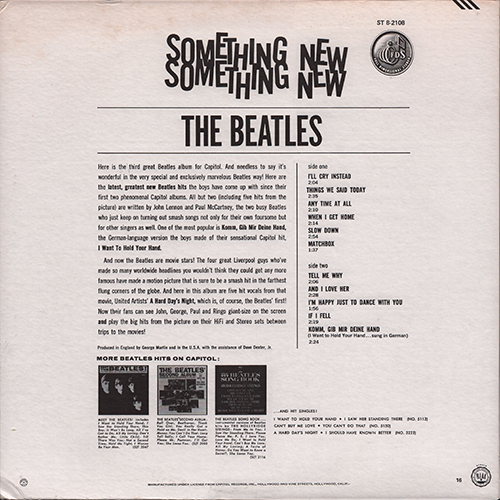 |
 |
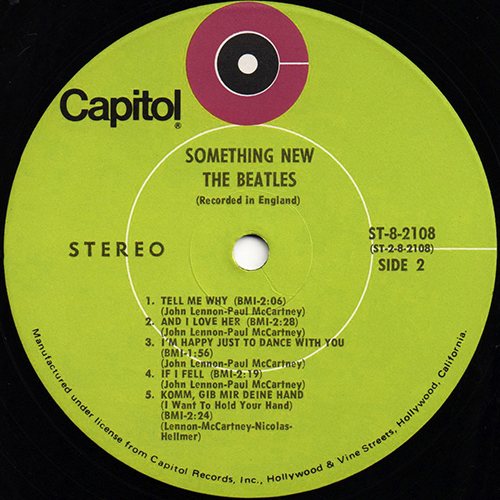 |
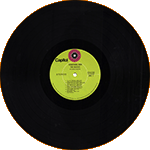 |
|
| INNER SLEEVE | FRONT COVER CLOSE UP | ||||
| FRONT--> Click! | BACK --> Click! | ||||
 |
 |
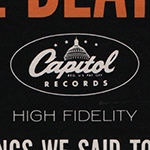 |
The Capitol logo and the
phrase "HIGH FIDELITY" appear in black at the right side of
the front cover. |
||
| FRONT COVER CLOSE UP | |||||
 |
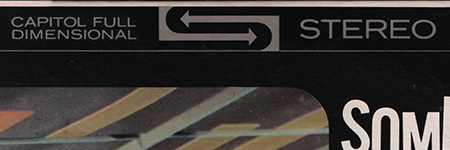 |
 |
|||
| Copies of non gatefold Capitol
albums that were released through the record club from 1969
through 1972 have three "hash marks" at the upper
left hand corner of the cover. These are visible from the
front and distinguish the albums from Capitol's regularly
issued LP's. On stereo jackets, the front cover slicks is cut and positioned to reveal the Capitol Full Demensional Stereo arrow logo at the top. None of the original record-club covers have the gFile Underh dot. |
Later copies of the covers to
Something New are missing the cover number. |
||||
| BACK COVER CLOSE UP --> Click! | |||||
 |
Have three "hash marks" at the upper right
hand corner of the front cover. |
 |
Back liner has the catalog number "ST 8- 2108". With "Full Dimentional Stereo" logo, WITHOUT "Also Available In Regular Monophonic" letters under the FDS logo. | ||
 |
The back liners have a small
numeral located near the lower right or left corner. These
numbers were used by Capitol to identify where the album
cover was manufactured. (16 = Longines) |
 |
"Printed in U.S.A." in a circular pattern. | ||
| BACK COVER CLOSE UP | |||||
 |
|||||
| After Longines took over the
record club in 1969, Capitol quit supplying albums to the
club. Instead, Longines arranged for the manufacture of
Capitol albums using cover artwork and label backdrops
supplied by Capitol. Most of the back liners for the album
jackets prepared for Longines contain the legend
"Manufactured under license from Capitol Records, Inc.,
Hollywood and Vine Streets, Hollywood, Calif." in uppercase
letters. |
|||||
| LABEL CLOSE UP | |||||
 |
 |
 |
|||
| Capitol's green label was
first issued in July, 1969 (to April 1971). It sports a new
Capitol logo: a gCh surrounding a record. So did the
record club; the change likely came in October. On this new
label, the licensing statement still indicates that the
records were made for Capitol Records. On early copies, the
word "STEREO" appears in the same type face that had been
used on the black-label issue – with "round" letters like
the ones that were being used on regular-issue Capitol
albums. The trademark registration can be found in one of two configurations: either as TM to the right of the word "Capitol" or as (R) underneath the l in "Capitol." Early 1969 wiith the "TM" next to "Capitol", later, in 1971, the "TM" was replaced with the more traditional "R" in a circle. |
|||||
 |
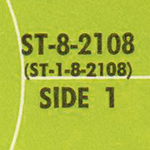 |
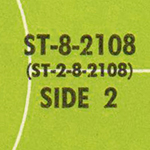 |
Longines altered the record
number of the LPs by adding the number "8" to the prefix.
The expanded record numbers appear on the record covers and
labels and in the trail off areas. Longines began pressing
Capitol Beatles albums in 1969, mono discs had been phased
out. Thus, there are no mono Longines pressings of Beatles
albums. |
||
| LABEL CLOSE UP | |||||
| SIDE 1 |
SIDE
2 |
The
club
issue album labels have full "John Lennon-Paul McCartney"
credits. (excepted #5 on side-2) |
|||
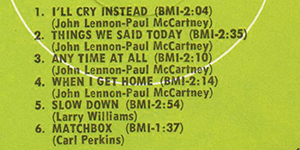 |
 |
||||
| LABEL CLOSE UP | |||||
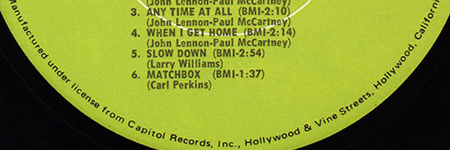 |
The text of the perimeter
print in black on the club issue discs states "Manufactured
under license from Capitol Records, Inc., Hollywood and Vine
Streets, Hollywood, California" in lowercase. |
||||
|
OTHER ITEM
|
|||||
| - |
|||||
| LABEL | Capitol
Green Target ® Label type-1 with Round STEREO |
||||
| MIX | STEREO |
||||
| VINYL COLOR | Black |
||||
| PRESS FACTORY | Longines |
||||
| FACTORY CODE | 16 |
||||
| MATRIX No. | SIDE 1 |
ST 1 82108 w1 21 (hand etched) | |||
| SIDE 2 |
ST 2 - 82108 w1 21 (hand etched) | ||||
| PUBLISHER'S NAME |
- |
||||
|
"SUBSIDIARY" PRINT
|
- |
||||
| COVER FORM |
Single type. Housed in a cardboard jacket. Front cover: with gloss varnish | ||||
| INNER SLEEVE | Plain
white inner sleeve |
||||
| COVER DESIGN/ PHOTO/ NOTES | photograph
taken by Ken Veeder of the group's 9th. February 1964, Ed
Sullivan Show debut |
||||
| PRODUCER | George
Martin |
||||
|
COMMENTS
|
When the Capitol Record Club began
operations in 1958, it entered a mail-order market dominated
by two clubs owned by other labels - Columbia and RCA. the
Capitol Records record club enticed people to join by
offering half-dozen or so "free" records in exchange for the
new member buying one record and agreeing to club membership
rules. Capitol's only hope of catching the competition was
to exploit the strength of its talent roster. Then in December 1968, Capitol had agreed to sell its direct marketing corporation, which included the Capitol record club to the Longines (Longines-Wittnauer) company. prior to Longines' purchase of the record club, The Beatles albums issued to club members were the same as the records shipped by Capitol to distributors and stores. After Longines took over the club in 1969, Capitol quit supplying albums to the club, instead Longines arranged for the manufacture of Capitol albums using cover artwork and label backdrops supplied by Capitol. The LP back covers have three angled black bars in the upper right hand corner which wrap around to the front cover in the upper left hand corner, and do not have the "File Under" information. Longines also altered the record number of the LPs by adding the number "8" to the prefix. By the time Longines began pressing Capitol Beatles albums in 1968, mono discs have been phased out. Thus, there are no mono Longines pressings of Beatles albums. These Longines Beatles albums are less common than the standard Capitol albums, which sold in the millions. The first records pressed for Longines have the Capitol rainbow label backdrops, while later issues have either green Capitol labels. "Something New (Capitol ST 2108)" is designated ST-8-2108. The expanded record numbers appear on the record covers and labels and in the trail off areas. None of the original record-club covers have the gFile Underh dot. The New Improved Full Dimensional Stereo logo was appeared at the top of the front cover slick. Back liner has the catalog number "ST 8- 2108". With "Full Dimentional Stereo" logo, WITHOUT "Also Available In Regular Monophonic" letters under the FDS logo. The back liners have a small numeral located near the lower right or left corner. These numbers were used by Capitol to identify where the album cover was manufactured. (16 = Longines) Label: Capitol Green Target label with R" in a circle. Capitol's green label was first issued in July, 1969 (to April 1971). It sports a new Capitol logo: a gCh surrounding a record. So did the record club; the change likely came in October. On this new label, the licensing statement still indicates that the records were made for Capitol Records. On early copies, the word "STEREO" appears in the same type face that had been used on the black-label issue – with "round" letters like the ones that were being used on regular-issue Capitol albums. On the label, The text of the perimeter print in blue on the club issue discs states "Manufactured under license from Capitol Records, Inc., Hollywood and Vine Streets, Hollywood, Calif." in lowercase. The club issue album labels have full "John Lennon-Paul McCartney" credits. (*) The Longines Symphonette Society: The Longines Symphonette Society was a direct marketing company working out of Larchmont and, later, New Rochelle, New York. These addresses were also printed on the labels of their releases. The company operated from the late-1960s until 1974, headed by Alan Cartoun, president, and son of Longines Watch Company Chairman, Fred Cartoun. The Longines Symphonette Society was a pioneer of using personalized computer-generated letters to promote LP records, 8-track tapes, electronics, books, and collectors' medallions. But their main business was mail-order LP box sets of classical and easy listening music, as well as releasing LPs of "old time radio" (OTR) programs. It purchased the record club edition rights to the catalog of Capitol Records from the label for its Capitol Record Club in 1968 and continued to press Capitol LPs for the club until 1975, when it was shut down. (from Discog) |
||||
|
TITLE
|
SOMETHING NEW |
||||
| CATALOG
NUMBER |
ST-8-2108 |
||||
|
RELEASE DATE
|
February 1973 / 4th Press | ||||
| TITLE LISTING |
SIDE
1 |
SIDE
2 |
|||
| I'll Cry Instead
(BMI-2:04) |
Tell Me Why
(BMI-2:06) |
||||
| Things We Said
Today (BMI-2:35) |
And I Love Her
(BMI-2:28) |
||||
| Any Time At All
(BMI-2:10) |
I'm Happy Just To Dance With You (BMI-1:56) | ||||
| When I Get Home
(BMI-2:14) |
If I Fell (BMI-2:19) | ||||
| Slow Down
(BMI-2:54) |
Komm, Gib Mir
Deine Hand (BMI-2:24) (Lennon-McCartney-Nicolas-Hellmer) |
||||
| Matchbox (BMI-1:37) | |||||
| FRONT--> Click! | BACK --> Click! | SIDE 1 --> Click! | SIDE 2 --> Click! | DISK --> Click! | |
 |
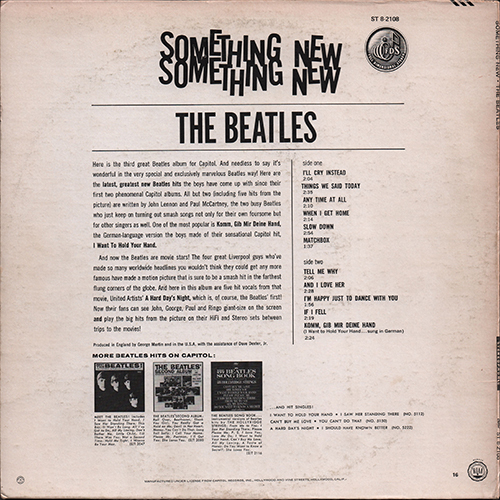 |
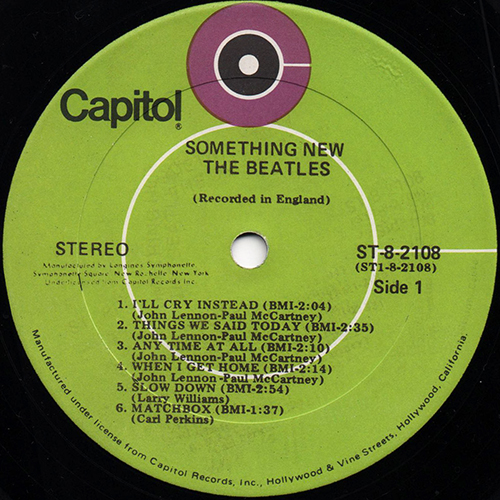 |
 |
 |
|
| INNER SLEEVE | FRONT COVER CLOSE UP | ||||
| FRONT--> Click! | BACK --> Click! | ||||
 |
 |
 |
 |
The Capitol logo and the phrase "HIGH FIDELITY" appear in black at the right side of the front cover. Later copies of the covers to Something New are missing the cover number. | |
| FRONT COVER CLOSE UP | |||||
 |
 |
||||
| Copies of non gatefold Capitol
albums that were released through the record club from 1969
through 1972 have three "hash marks" at the upper
left hand corner of the cover. These are visible from the
front and distinguish the albums from Capitol's regularly
issued LP's. On stereo jackets, the front cover slicks is cut and positioned to reveal the Capitol Full Demensional Stereo arrow logo at the top. |
|||||
| BACK COVER CLOSE UP --> Click! | |||||
 |
 |
 |
 |
||
| Have three "hash marks" at the upper right hand corner of the front cover. Back liner has the catalog number "ST 8- 2108". With "Full Dimentional Stereo" logo, WITHOUT "Also Available In Regular Monophonic" letters under the FDS logo. | The back liners
have a small numeral located near the lower right or left
corner. These numbers were used by Capitol to identify where
the album cover was manufactured. (16 = Longines) "Printed in U.S.A." in a circular pattern. |
||||
| BACK COVER CLOSE UP | |||||
 |
|||||
| After Longines took over the
record club in 1969, Capitol quit supplying albums to the
club. Instead, Longines arranged for the manufacture of
Capitol albums using cover artwork and label backdrops
supplied by Capitol. Most of the back liners for the album
jackets prepared for Longines contain the legend
"Manufactured under license from Capitol Records, Inc.,
Hollywood and Vine Streets, Hollywood, Calif." in uppercase
letters. |
|||||
| LABEL CLOSE UP --> Click! | |||||
 |
 |
 |
|||
| Capitol's green label was
first issued in July, 1969 (to April 1971). It sports a new
Capitol logo: a gCh surrounding a record. So did the
record club; the change likely came in October. The trademark registration can be found in one of two configurations: either as TM to the right of the word "Capitol" or as (R) underneath the l in "Capitol." Early 1969 wiith the "TM" next to "Capitol", later, in 1971, the "TM" was replaced with the more traditional "R" in a circle. By about the February 1973, Longines was placing their own name on the labels (and in some cases, the covers), indicating that the record club was theirs. |
|||||
 |
 |
 |
Longines altered the record
number of the LPs by adding the number "8" to the prefix.
The expanded record numbers appear on the record covers and
labels and in the trail off areas. Longines began pressing
Capitol Beatles albums in 1969, mono discs had been phased
out. Thus, there are no mono Longines pressings of Beatles
albums. |
||
| LABEL CLOSE UP | |||||
| SIDE 1 |
SIDE
2 |
The
club
issue
album labels have full "John Lennon-Paul McCartney" credits. (excepted #5 on side-2) |
|||
 |
 |
||||
| LABEL CLOSE UP | |||||
 |
The text of the perimeter
print in black on the club issue discs states "Manufactured
under license from Capitol Records, Inc., Hollywood and Vine
Streets, Hollywood, California" in lowercase. |
||||
|
OTHER ITEM
|
|||||
| - |
|||||
| LABEL | Capitol
Green Target ® Label type-3 with Longines Print |
||||
| MIX | STEREO |
||||
| VINYL COLOR | Black |
||||
| PRESS FACTORY | Longines |
||||
| FACTORY CODE | 16 |
||||
| MATRIX No. | SIDE 1 |
ST 1 82108 w1-1 21 D (hand etched) | |||
| SIDE 2 |
ST 2 82108 w1-1 21 D (hand etched) | ||||
| PUBLISHER'S NAME |
- |
||||
|
"SUBSIDIARY" PRINT
|
- |
||||
| COVER FORM |
Single type. Housed in a cardboard jacket. Front cover: with gloss varnish | ||||
| INNER SLEEVE | Plain
white inner sleeve |
||||
| COVER DESIGN/ PHOTO/ NOTES | photograph
taken
by Ken Veeder of the group's 9th. February 1964, Ed Sullivan
Show debut |
||||
| PRODUCER | George
Martin |
||||
|
COMMENTS
|
When the Capitol Record Club began
operations in 1958, it entered a mail-order market dominated
by two clubs owned by other labels - Columbia and RCA. the
Capitol Records record club enticed people to join by
offering half-dozen or so "free" records in exchange for the
new member buying one record and agreeing to club membership
rules. Capitol's only hope of catching the competition was
to exploit the strength of its talent roster. Then in December 1968, Capitol had agreed to sell its direct marketing corporation, which included the Capitol record club to the Longines (Longines-Wittnauer) company. prior to Longines' purchase of the record club, The Beatles albums issued to club members were the same as the records shipped by Capitol to distributors and stores. After Longines took over the club in 1969, Capitol quit supplying albums to the club, instead Longines arranged for the manufacture of Capitol albums using cover artwork and label backdrops supplied by Capitol. The LP back covers have three angled black bars in the upper right hand corner which wrap around to the front cover in the upper left hand corner, and do not have the "File Under" information. Longines also altered the record number of the LPs by adding the number "8" to the prefix. By the time Longines began pressing Capitol Beatles albums in 1968, mono discs have been phased out. Thus, there are no mono Longines pressings of Beatles albums. These Longines Beatles albums are less common than the standard Capitol albums, which sold in the millions. The first records pressed for Longines have the Capitol rainbow label backdrops, while later issues have either green Capitol labels. "Something New (Capitol ST 2108)" is designated ST-8-2108. The expanded record numbers appear on the record covers and labels and in the trail off areas. None of the original record-club covers have the gFile Underh dot. Full Dimensional Stereo logo was appeared at the top of the front cover slick. Back liner has the catalog number "ST 8- 2108". With "Full Dimentional Stereo" logo, WITHOUT "Also Available In Regular Monophonic" letters under the FDS logo. The back liners have a small numeral located near the lower right or left corner. These numbers were used by Capitol to identify where the album cover was manufactured. (16 = Longines) By about the February 1973, Longines was placing their own name on the labels (and in some cases, the covers), indicating that the record club was theirs. Only a few "green label" Capitol Beatles records were issued through the club on this label style:
Label: Capitol Green Target label with R" in a circle. Capitol's green label was first issued in July, 1969 (to April 1971). It sports a new Capitol logo: a gCh surrounding a record. So did the record club; the change likely came in October. On this new label, the licensing statement still indicates that the records were made for Capitol Records. On early copies, the word "STEREO" appears in the same type face that had been used on the black-label issue – with "round" letters like the ones that were being used on regular-issue Capitol albums. On the label, The text of the perimeter print in blue on the club issue discs states "Manufactured under license from Capitol Records, Inc., Hollywood and Vine Streets, Hollywood, Calif." in lowercase. The club issue album labels have full "John Lennon-Paul McCartney" credits. (*) The Longines Symphonette Society: The Longines Symphonette Society was a direct marketing company working out of Larchmont and, later, New Rochelle, New York. These addresses were also printed on the labels of their releases. The company operated from the late-1960s until 1974, headed by Alan Cartoun, president, and son of Longines Watch Company Chairman, Fred Cartoun. The Longines Symphonette Society was a pioneer of using personalized computer-generated letters to promote LP records, 8-track tapes, electronics, books, and collectors' medallions. But their main business was mail-order LP box sets of classical and easy listening music, as well as releasing LPs of "old time radio" (OTR) programs. It purchased the record club edition rights to the catalog of Capitol Records from the label for its Capitol Record Club in 1968 and continued to press Capitol LPs for the club until 1975, when it was shut down. (from Discog) |
||||